NOTE: Use a digital multimeter to make all electrical measurements.
PINPOINT TEST A: POWER WINDOWS DO NOT WORK ON ALL WINDOWS - WINDOWS WITH ELECTRIC FRONT AND REAR WINDOWS
|
STATES |
DETAILS/RESULTS/ACTIONS |
|
A1: DRIVER'S DOOR WINDOW SWITCH LED TEST |
|
|
1 Drive the ON position. |
|
|
• Are the driver's door power window switch LEDs lit? |
|
|
→ Yes |
|
|
CHECK the customer's complaint. |
|
|
→ No |
|
|
3-door variant, 5-door variant and "station wagon" Go to A2 4 door variant: REPAIR circuit 15 - DA5 (green-orange). CHECK the system is working properly. |
|
|
A2: REAR WINDOW WIPER MOTOR CHECK |
|
|
1 Turn on the rear window wiper. |
|
|
• Is the rear window wiper working properly? |
|
|
→ Yes |
|
|
REPAIR circuit 15 - DA5 (green-orange). CHECK the system is working properly. |
|
|
→ No |
|
|
REPAIR circuit 15 - KA28 (green-blue). CHECK the system is working properly. |
|
PINPOINT TEST B: ONE ELECTRIC WINDOW - WINDOW DOES NOT WORK WITH ELECTRIC FRONT AND REAR WINDOWS
|
STATES |
DETAILS/RESULTS/ACTIONS |
|
B1: CHECKING THE IGNITION VOLTAGE IN THE POWER WINDOW SWITCH ISN'T WORKING |
|
|
NOTE: Make sure the rear window switch lock is not engaged. |
|
|
1 Drive the ON position. |
|
|
• Is the power window inoperative switch LED on? |
|
|
→ Yes |
|
|
Navigate to B2 |
|
|
→ No |
|
|
Go to B6 |
|
|
B2: CHECKING POSSIBILITY OF OPERATING POWER WINDOW USING THE POWER WINDOW SWITCH LOCATED ON THE DRIVER'S DOOR |
|
|
1 Operate the power window switch located on the driver's door. |
|
|
• Does the non-working power window operate correctly? |
|
|
→ Yes |
|
|
Driver's window power window, CHECK customer's complaint. Power windows on all passenger doors, Go to B3 |
|
|
→ No |
|
|
Go to B8 |
|
|
B3: CONTINUITY CHECK OF THE ELECTRICAL CIRCUIT BETWEEN THE IN-WORKING WINDOW SWITCH AND THE WINDOW LIFT MOTOR |
|
|
1 Disconnect the C735, C736 or C737 of the inoperative power window motor. |
|
|
2 Disconnect C485, C482 or C483 inoperative power window switch. |
|
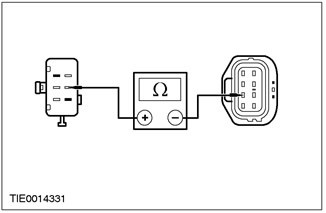
|
3 Measure the resistance between pin 5 of connector C485, front passenger window inoperative power window switch, circuit 31S - AJ55B (red-black), and pin 3 of the power window motor connector C735, circuit 31S - AJ55A (red-black), from the wiring side; or between pin 5 of connector C482 of left rear window inoperative window switch, circuit 31S - AJ46B (black and white), and pin 3 of the power window motor connector C736, circuit 31S - AJ46A (black and white), from the wiring side; or between pin 5 of connector C483, right rear window inoperative window switch, circuit 31S - AJ46B (black and white), and pin 3 of the power window motor connector C737, circuit 31S - AJ46A (black and white), from the side of the electrical wiring. |
|
• Is the resistance less than 5 ohms? |
|
|
→ Yes |
|
|
Go to B4 |
|
|
→ No |
|
|
REPAIR circuit 31S - AJ55B (red-black); or electrical circuit 31S - AJ46B (black and white). CHECK the system is working properly. |
|
|
B4: CONTINUITY CHECK OF THE ELECTRICAL CIRCUIT BETWEEN THE IN-WORKING WINDOW SWITCH AND THE WINDOW DOWN MOTOR |
|
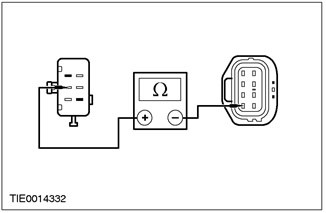
|
1 Measure the resistance between pin 2 of connector C485, passenger's front window inoperative window switch, circuit 31S - AJ54B (black and green), and pin 4 of the power window motor connector C735, circuit 31S - AJ54A (black and green), from the wiring side; or between pin 2 of connector C482 of left rear window inoperative window switch, circuit 31S - AJ63B (black and green), and pin 4 of the power window motor connector C736, circuit 31S - AJ63A (black and blue), from the wiring side; or between pin 2 of connector C483 of right rear window inoperative window switch, circuit 31S - AJ63B (black and blue), and pin 4 of the power window motor connector C737, circuit 31S - AJ63A (black and blue), from the side of the electrical wiring. |
|
• Is the resistance less than 5 ohms? |
|
|
→ Yes |
|
|
Go to B5 |
|
|
→ No |
|
|
REPAIR circuit 31S - AJ54B (black and green); or electric circuit 31S - AJ63B (black and green); or electric circuit 31S - AJ63B (black and blue). CHECK the system is working properly. |
|
|
B5: INDOOR POWER WINDOW MOTOR GROUND CIRCUIT CHECK |
|
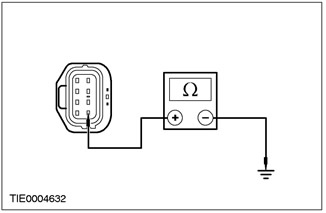
|
1 Measure the resistance between pin 8 of connector C734, driver's window inoperative power window motor, circuit 31 - AJ26 (black), from the wiring side, and "weight"; or pin 8 of connector C735, front passenger window inoperative power window motor, circuit 31 - AJ27 (black), from the wiring side, and "weight"; or pin 8 of connector C736, left rear window inoperative power window motor, circuit 31 - AJ31 (black), from the wiring side, and "weight"; or pin 8 of connector C737 of the right rear window inoperative window motor, circuit 31 - AJ31 (black), from the wiring side, and "weight". |
|
• Is the resistance less than 5 ohms? |
|
|
→ Yes |
|
|
CHECK the customer's complaint. |
|
|
→ No |
|
|
REPAIR circuit 31 - AJ26 (black); or circuit 31 - AJ27 (black); or circuit 31 - AJ31 (black). CHECK the system is working properly. |
|
|
B6: POWER WINDOW SWITCH VOLTAGE CHECK |
|
|
1 Enter the OFF position. |
|
|
2 Disconnect C484, C485, C482, C483 inoperative power window switch. |
|
|
3 Drive the ON position. |
|
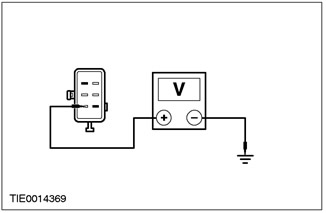
|
4 Measure the voltage between pin 13 of connector C484, driver's window inoperative power window switch, circuit 15 - LH14 (yellow-green), from the wiring side, and "weight"; or between pin 1 of connector C485, front passenger window inoperative power window switch, circuit 15 - LH31 (green-blue), from the wiring side, and "weight"; or between pin 1 of connector C482 of left rear window inoperative window switch, circuit 15 - LH36 (red-green), from the wiring side, and "weight"; or between pin 1 of connector C483 right rear window door inoperative window switch, circuit 15 - LH36 (red-green), from the wiring side, and "weight" (passenger window shown). |
|
• Is the voltage greater than 10 V? |
|
|
→ Yes |
|
|
Go to B7 |
|
|
→ No |
|
|
Go to B14 |
|
|
B7: INDOOR WINDOW SWITCH GROUND CIRCUIT CHECK |
|
|
1 Enter the OFF position. |
|
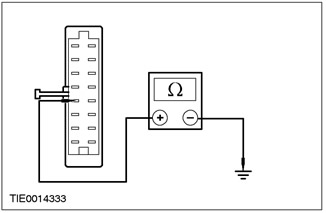
|
2 Measure the resistance between pin 4 of connector C484, driver's window inoperative window switch, circuit 31 - AJ7 (black), from the wiring side, and "weight"; or between pin 6 of connector C485, front passenger window inoperative power window switch, circuit 31 - AJ18 (black), from the wiring side, and "weight"; or between pin 6 of connector C482 of left rear window inoperative power window switch, circuit 31S - AJ32 (black-orange), from the wiring side, and "weight"; or between pin 6 of connector C483 of right rear window inoperative window switch, circuit 31S - AJ32 (black-orange), from the wiring side, and "weight" (driver window shown). |
|
• Is the resistance less than 5 ohms? |
|
|
→ Yes |
|
|
REPAIR circuit 32-AJ26 (white). |
|
|
→ No |
|
|
REPAIR circuit 31 - AJ7 (black); or electrical circuit 31 - AJ18 (black); or electric circuit 31S - AJ32 (black and orange) or 31S - AJ14 (black and orange); or electric circuit 31S - AJ32 (black and orange) or 31S - AJ24 (black and yellow). CHECK the system is working properly. |
|
|
B8: CHECKING THE VOLTAGE IN THE PLUG CONNECTOR OF THE DOOR WITH THE POWER WINDOW OFF |
|
|
1 Enter the OFF position. |
|
|
2 Disconnect C42, C44, C45 or C46 doors with inoperative power windows. |
|
|
3 Drive the ON position. |
|
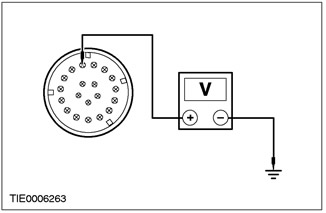
|
4 Measure the voltage between pin 9 of connector C42 on driver's door with power window inoperative, circuit 29 - AJ26 (yellow-orange), from the wiring side, and "weight"; or pin 9 of connector C44 on the front passenger door with inoperative power window, circuit 29 - AJ27 (orange white), from the wiring side, and "weight"; or pin 9 of connector C45 on the left rear door with inoperative power window, circuit 29 - AJ13 (orange-blue), from the wiring side, and "weight"; or pin 9 of connector C46 on the right rear door with inoperative power window, circuit 29 - AJ23 (orange white), from the wiring side, and "weight". |
|
• Is the voltage greater than 10 V? |
|
|
→ Yes |
|
|
Go to B9 |
|
|
→ No |
|
|
REPAIR circuit 29 - AJ26 (yellow-orange); or electrical circuit 29 - AJ27 (orange-white); or electrical circuit 29 - AJ13 (orange-blue); or electrical circuit 29 - AJ23 (orange-white). CHECK the system is working properly. |
|
|
B9: INDOOR POWER WINDOW MOTOR GROUND CIRCUIT CHECK |
|
|
1 Enter the OFF position. |
|
|
2 Disconnect the C734, C735, C736 or C737 of the inoperative power window motor. |
|
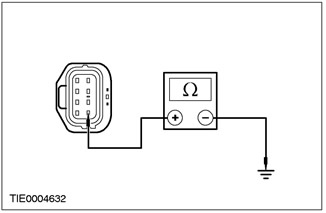
|
3 Measure the resistance between pin 8 of connector C734, driver's window inoperative power window motor, circuit 31 - AJ26 (black), from the wiring side, and "weight"; or pin 8 of connector C735, front passenger window inoperative power window motor, circuit 31 - AJ27 (black), from the wiring side, and "weight"; or pin 8 of connector C736, left rear window inoperative power window motor, circuit 31 - AJ31 (black), from the wiring side, and "weight"; or pin 8 of connector C737 of the right rear window inoperative window motor, circuit 31 - AJ31 (black), from the wiring side, and "weight". |
|
• Is the resistance less than 5 ohms? |
|
|
→ Yes |
|
|
Go to B10 |
|
|
→ No |
|
|
REPAIR circuit 31 - AJ26 (black); or circuit 31 - AJ27 (black); or circuit 31 - AJ31 (black). CHECK the system is working properly. |
|
|
B10: CHECKING THE VOLTAGE IN THE PLUG CONNECTOR OF THE ELECTRIC WINDOW MOTOR IN AN OUT OF WORK |
|
|
1 Connect C42, C44, C45 or C46 of the inoperative power window motor. |
|
|
2 Drive the ON position. |
|
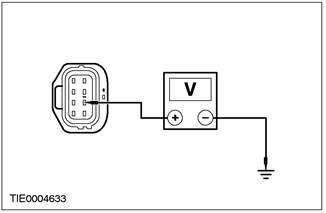
|
3 Measure the voltage between pin 7 of connector C734, driver's window inoperative power window motor, circuit 29 - AJ26 (yellow-orange), from the wiring side, and "weight"; or pin 7 of connector C735, front passenger window inoperative power window motor, circuit 29 - AJ27 (orange white), from the wiring side, and "weight"; or pin 7 of connector C736 of the left rear window inoperative window motor, circuit 29 - AJ31 (orange-blue), from the wiring side, and "weight"; or pin 7 of connector C737 of the right rear window inoperative power window motor, circuit 29 - AJ31 (orange-blue), from the wiring side, and "weight". |
|
• Is the voltage greater than 10 V? |
|
|
→ Yes |
|
|
Go to B11 |
|
|
→ No |
|
|
REPAIR circuit 29 - AJ26 (yellow-orange); or electrical circuit 29 - AJ27 (orange-white); or electrical circuit 29 - AJ31 (orange-blue). CHECK the system is working properly. |
|
|
B11: VOLTAGE CHECK IN THE ELECTRICAL WINDOW LIFT MOTOR CIRCUIT OF THE POWER WINDOW IN OUT OF WORK |
|
|
1 Enter position OFF.label |
|
|
2 Turn the inoperative power window motor switch to the up position. |
|
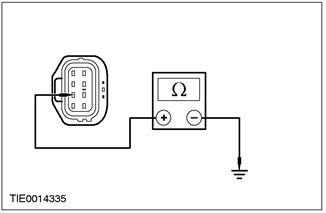
|
3 Measure the resistance between pin 3 of connector C734, driver's window inoperative power window motor, circuit 31S - AJ41 (red-black) - left-hand drive version ([black-orange] - right-hand drive variant), from the wiring side, and "weight"; or pin 3 of connector C735, front passenger window inoperative motor, circuit 31S - AJ55A (red-black), from the wiring side, and "weight"; or pin 3 of connector C736 of left rear window inoperative window motor, circuit 31S - AJ46A (black and white), from the wiring side, and "weight"; or pin 3 of connector C737 of the right rear window inoperative window motor, circuit 31S - AJ46A (black and white), from the wiring side, and "weight". |
|
• Is the resistance less than 5 ohms? |
|
|
→ Yes |
|
|
Move to B12 |
|
|
→ No |
|
|
REPAIR circuit 31S - AJ41 (red-black) - left-hand drive version ([black-orange] - right-hand drive variant); or electrical circuit 31S - AJ55A (red-black) or 31S - AJ55B (red-black); or electric circuit 31S - AJ46A (red-black); or electric circuit 31S - AJ46A (black and white) or 31S - AJ46B (black and white). CHECK the system is working properly. |
|
|
B12: VOLTAGE CHECK IN THE ELECTRICAL CIRCUIT OF THE ELECTRIC DOWN WINDOW ELECTRICITY WINDOW ISN'T WORKING |
|
|
1 Turn the inoperative power window motor switch to the window down position. |
|
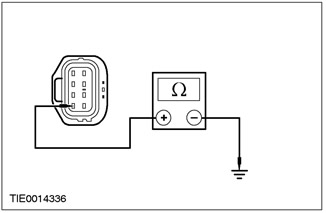
|
2 Measure the resistance between pin 4 of connector C734, driver's window inoperative power window motor, circuit 31S - AJ40 (black and green) - left-hand drive version ([black-blue] - right-hand drive variant), from the wiring side, and "weight"; or pin 4 of connector C735, passenger's window inoperative power window motor, circuit 31S - AJ54A (black and green), from the wiring side, and "weight"; or pin 4 connector C736 of the left rear window inoperative window motor, circuit 31S - AJ63A (black and blue), from the wiring side, and "weight"; or pin 4 connector C737 right rear window inoperative power window motor, circuit 31S - AJ63A (black and blue), from the wiring side, and "weight". |
|
• Is the resistance less than 5 ohms? |
|
|
→ Yes |
|
|
Go to B13 |
|
|
→ No |
|
|
REPAIR circuit 31S - AJ40 (black and green) - left-hand drive version ([black-blue] - right-hand drive variant); or electrical circuit 31S - AJ54A (black and green) or 31S - AJ54B (black and green); or electric circuit 31S - AJ63A (black and blue) or electric circuit 31S - AJ63B (black and green). CHECK the system is working properly. |
|
|
B13: CHECKING THE VOLTAGE IN THE ELECTRIC WINDOW MOTOR OFF |
|
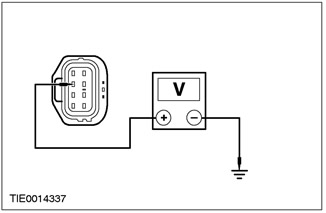
|
1 Measure the voltage between pin 2 of connector C734, driver's window inoperative power window motor, circuit 15 - AJ26 (yellow-green), from the wiring side, and "weight"; or pin 2 of connector C735, passenger's window inoperative power window motor, circuit 31S - AJ27A (white-green), from the wiring side, and "weight"; or pin 2 of connector C736, left rear window inoperative power window motor, circuit 31S - AJ31A (green-blue), from the wiring side, and "weight"; or pin 2 connector C737 right rear window inoperative power window motor, circuit 31S - AJ31A (green-blue), from the wiring side, and "weight". |
|
• Is the voltage greater than 10 V? |
|
|
→ Yes |
|
|
INSTALL a new motor. CHECK the system is working properly. |
|
|
→ No |
|
|
REPAIR circuit 15 - AJ26A (yellow-green); or electrical circuit 31S - AJ27A (white-green) or 31S - AJ54B (black and green); or electrical circuit 31S - AJ31A (green-blue). CHECK the system is working properly. |
|
|
B14: VOLTAGE CHECK IN THE DOOR CONNECTOR WITH THE POWER WINDOW OUT OF WORK |
|
|
1 Disconnect C42, C44, C45 or C46 on a door with an inoperative power window. |
|
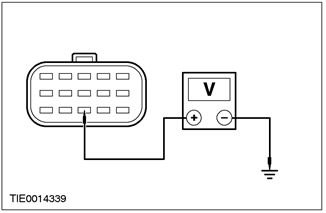
|
2 Measure the voltage between pin 15 of connector C42 on driver's door with power window inoperative, circuit 15 - AJ26 (yellow-green) - left-hand drive version (circuit 15 - AJ27 [white-green] - right-hand drive version), from the side of the rack "A", And "weight"; or pin 15 of connector C44 on the front passenger door with inoperative power window, circuit 15 - AJ27 (white-green) - left-hand drive version (circuit 15 - AJ26 [yellow-green] - right-hand drive version), from the side of the rack "A", And "weight"; or pin 13 of connector C45 on the left rear door with inoperative power window, circuit 15 - AJ13 (green-blue), from the side of the rack "IN", And "weight"; or pin 13 of connector C46 on the right rear door with inoperative power window, circuit 15 - AJ13 (green-blue), from the side of the rack "IN", And "weight" (rack shown "IN"). |
|
• Is the voltage greater than 10 V? |
|
|
→ Yes |
|
|
REPAIR circuit 15 - AJ26 (yellow-green) door side or circuit 15 - LH14 (yellow-green); or electrical circuit 15 - AJ27 (white-green) or electrical circuit 15 - LH31 (green-blue); or electrical circuit 15 - AJ31 (green-blue) or 15 - LH36 (red-green). CHECK the system is working properly. |
|
|
→ No |
|
|
REPAIR circuit 15 - AJ26 (yellow-green), from the side of the rack "A"; or electrical circuit 15 - AJ27 (white-green); or electrical circuit 15 - AJ13 (green-blue). CHECK the system is working properly. |
|
PINPOINT TEST C: GENERAL CLOSE FUNCTION DOES NOT WORK
|
STATES |
DETAILS/RESULTS/ACTIONS |
|
NOTE: Make sure all power window motors have been initialized. |
|
|
C1: CHECK CENTRAL TIMER MODULE CONNECTION TO CENTRAL ALARM UNIT. |
|
|
1 Check the lock button on the remote control. |
|
|
• Do the interior lights go out? |
|
|
→ Yes |
|
|
Go to C2 |
|
|
→ No |
|
|
REPAIR the electrical circuit (And). REFER to Section 419 - 10. |
|
|
C2: VOLTAGE CHECK IN THE POWER WINDOW CONNECTOR NOT WORKING |
|
|
1 Disconnect C42, C44, C45 or C46 on a door with an inoperative power window. |
|
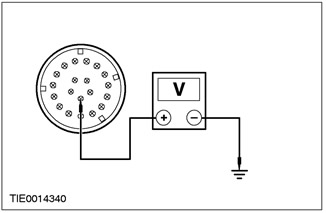
|
2 Measure the voltage between pin 16 of connector C42 on driver's door with power window inoperative, circuit 8 - AJ42 (white-green), from the side of the rack "A", And "weight" (shown); or pin 16 of connector C44 on the front passenger door with inoperative power window, circuit 8 - AJ56 (white-green), from the side of the rack "A", And "weight"; or pin 11 of connector C45 on the left rear door with inoperative power window, circuit 8 - AJ59 (white-green), from the side of the rack "IN", And "weight"; or pin 11 of connector C46 on the right rear door with inoperative power window, circuit 8 - AJ62 (white-green), from the side of the rack "IN", And "weight". |
|
• Is the voltage greater than 10 V? |
|
|
→ Yes |
|
|
Go to C3 |
|
|
→ No |
|
|
Go to C4 |
|
|
C3: CHECKING THE VOLTAGE IN THE POWER WINDOW MOTOR ISN'T WORKING |
|
|
1 Connect the plug connector on the door with the power window not working. |
|
|
2 Disconnect the inoperative power window motor plug connector. |
|
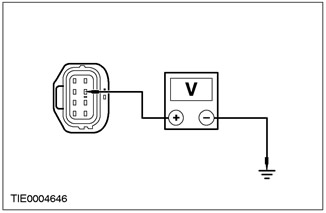
|
3 Measure the voltage between pin 6 of connector C734, driver's window inoperative power window motor, circuit 8 - AJ42 (white-green), from the wiring side, and "weight"; or pin 6 of connector C735, passenger window inoperative motor, circuit 8 - AJ56 (white-green), from the wiring side, and "weight"; or pin 6 of connector C737 of the left rear window inoperative window motor, circuit 8 - AJ65 (white-green), from the wiring side, and "weight"; or pin 6 of connector C736, right rear window inoperative power window motor, circuit 8 - AJ65 (white-green) or 8 - AJ65 (white-green), from the wiring side, and "weight". |
|
• Is the voltage greater than 10 V? |
|
|
→ Yes |
|
|
INSTALL a new motor. REFER to the procedure in this section: "Door Window Motor". CHECK the system is working properly. |
|
|
→ No |
|
|
REPAIR circuit 8 - AJ42 (white-green); or 8 - AJ56 (white-green) or 8 - AJ65 (white-green). CHECK the system is working properly. |
|
|
C4: CHECK FLOOR WIRING FOR SHORT CIRCUIT TO "MASS" |
|
|
NOTE: Circuit numbers change in splice S152. |
|
|
1 Disconnect all door connectors: C42, C44, C45 and C46.. |
|
|
2 Disconnect the C1000 central timer module. |
|
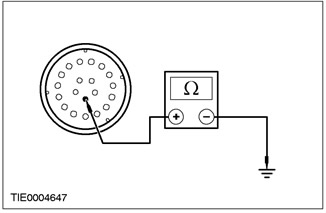
|
3 Measure the resistance between pin 16 of connector C42 on the driver's door, circuit 8 - AJ42 (white-green), from the side of the rack "A", And "weight". |
|
• Is the resistance greater than 10,000 ohms? |
|
|
→ Yes |
|
|
Go to C5 |
|
|
→ No |
|
|
REPAIR floor wiring harness circuit 8 - AJ42 (white-green); or 8 - AJ56 (white-green); or 8 - AJ59 (white-green); or 8 - AJ65 (white-green). CHECK the system is working properly. |
|
|
C5: CONTINUITY CHECK OF THE ELECTRICAL CIRCUIT BETWEEN DRIVER'S DOOR WINDOW CONNECTOR AND CENTRAL JUNCTION BOX |
|
|
1 Disconnect the C15 of the central electrical box. |
|
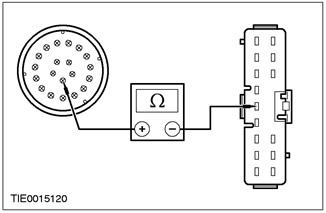
|
2 Measure the resistance between pin 16 of connector C42 on the driver's door, circuit 8 - AJ42 (white-green), from the side of the rack "A", and pin 11 of connector C15 of the central electrical box, circuit 8 - AA36 (white), from the side of the electrical wiring. |
|
• INSTALL a new relay. |
|
|
→ Yes |
|
|
Go to C6 |
|
|
→ No |
|
|
REPAIR circuit 8 - AA36 or 8 - AA36A (white). REPAIR circuit 32-AJ26 (white). |
|
|
C6: CONTINUITY CHECK OF THE ELECTRICAL CIRCUIT BETWEEN DRIVER'S DOOR WINDOW CONNECTOR AND CENTRAL ALARM UNIT |
|
|
1 Disconnect the C451 central security unit. |
|
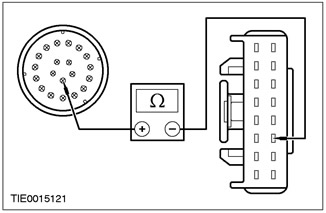
|
2 Measure the resistance between pin 16 of connector C42 on the driver's door, circuit 8 - AJ42 (white-green), from the side of the rack "A", and pin 14 of connector C451, circuit 8 - AA36 (white), from the side of the electrical wiring. |
|
• INSTALL a new switch. |
|
|
→ Yes |
|
|
CHECK the customer's complaint. |
|
|
→ No |
|
|
REPAIR circuit 8 - AA36 (white). CHECK the system is working properly. |
|
PINPOINT TEST D: POWER WINDOWS DO NOT WORK ON ALL WINDOWS - POWER WINDOWS IN FRONT DOORS
|
STATES |
DETAILS/RESULTS/ACTIONS |
|
D1: VOLTAGE CHECK IN WINDOW SWITCHES |
|
|
1 Drive the ON position. |
|
|
• Are the power window switch LEDs lit? |
|
|
→ Yes |
|
|
Go to D2 |
|
|
→ No |
|
|
Go to D3 |
|
|
D2: DRIVER'S DOOR WINDOW SWITCH GROUND CONTINUITY CHECK |
|
|
1 Enter the OFF position. |
|
|
2 Disconnect the C488 driver's window power window switch. |
|
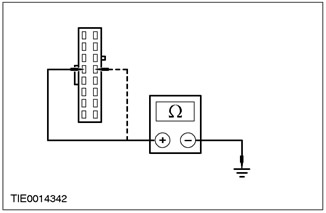
|
3 Measure the resistance between pin 5 (left hand drive variant) (or pin 13, right hand drive version) C488 Driver's Door Power Window Switch Connector Circuit 31 - AJ7 (black), from the wiring side, and "weight". |
|
• INSTALL a new switch. |
|
|
→ Yes |
|
|
CHECK the customer's complaint. |
|
|
→ No |
|
|
REPAIR circuit 31 - AJ7 (black). CHECK the system is working properly. |
|
|
D3: DRIVER'S DOOR WINDOW SWITCH VOLTAGE CHECK |
|
|
1 Enter the OFF position. |
|
|
2 Disconnect the C488 driver's window power window switch. |
|
|
3 Drive the ON position. |
|
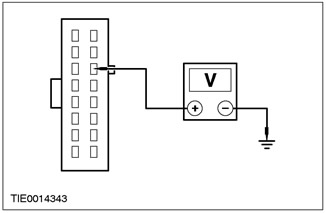
|
4 Measure the voltage between pin 14 of connector C488, driver's window power window switch, circuit 15 - LH14 (yellow-green), from the wiring side, and "weight". |
|
• Is the voltage greater than 10 V? |
|
|
→ Yes |
|
|
CHECK the customer's complaint. |
|
|
→ No |
|
|
Repair circuit 15 LH14 (yellow-green). CHECK the system is working properly. |
|
PINPOINT TEST E: ONE WINDOW ELECTRIC WINDOW DOES NOT WORK - DRIVER SIDE
|
STATES |
DETAILS/RESULTS/ACTIONS |
|
E1: DRIVER'S DOOR WINDOW SWITCH VOLTAGE TEST |
|
|
1 Drive the ON position. |
|
|
• Is the driver's door power window switch LED on? |
|
|
→ Yes |
|
|
Go to E2 |
|
|
→ No |
|
|
Go to E7 |
|
|
E2: CHECK SWITCH VOLTAGE IN DRIVER'S DOOR WINDOW SWITCH |
|
|
1 Operate the front passenger's window power window control switch located on the driver's door. |
|
|
• Is the front passenger's window regulator operated by a switch located on the driver's door? |
|
|
→ Yes |
|
|
Go to E3 |
|
|
→ No |
|
|
Go to E9 |
|
|
E3: OPEN FUNCTION RELAY TEST "ONE TOUCH" |
|
|
1 Operate the driver's window power window switch to the first detent position. |
|
|
• Opening function relay "one touch" works with a distinct sound? |
|
|
→ Yes |
|
|
Go to E4 |
|
|
→ No |
|
|
Go to E10 |
|
|
E4: DRIVER'S DOOR WINDOW WINDOW DROP MOTOR VOLTAGE CHECK |
|
|
1 Enter the OFF position. |
|
|
2 Disconnect the C782 driver's window power window motor.. |
|
|
3 Drive the ON position. |
|
|
4 Operate the driver's window power window switch to the first detent in the down direction. |
|
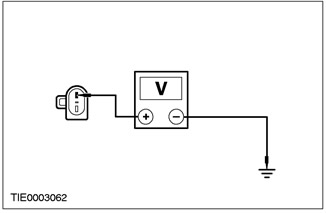
|
5 Measure the voltage between pin 2 of connector C782 of the driver's window motor, circuit 32 - AJ26 (white), And "weight". |
|
• Is the voltage greater than 10 V? |
|
|
→ Yes |
|
|
Go to E5 |
|
|
→ No |
|
|
Go to E13 |
|
|
E5: DRIVER'S DOOR WINDOW LIFT MOTOR VOLTAGE CHECK |
|
|
1 Operate the driver's window power window switch to the first detent in the up direction. |
|
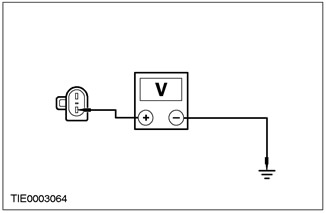
|
2 Measure the voltage between C782 pin 1 of the driver's window motor, circuit 32 - AJ26 (yellow), And "weight". |
|
• Is the voltage greater than 10 V? |
|
|
→ Yes |
|
|
Go to E6 |
|
|
→ No |
|
|
REPAIR circuit 33 - AJ26 (yellow). CHECK the system is working properly. |
|
|
E6: DRIVER'S DOOR WINDOW WINDOW MOTOR GROUND CONTINUITY CHECK |
|
|
1 Enter the OFF position. |
|
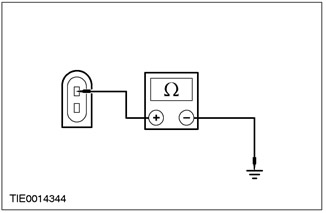
|
2 Measure the resistance between pin 2 of connector C782, driver's window motor, circuit 33 - AJ26 (white), And "weight". |
|
• CHECK the customer's complaint. |
|
|
→ Yes |
|
|
INSTALL a new motor. REFER to the procedure in this section: "Door Window Motor". CHECK the system is working properly. |
|
|
→ No |
|
|
INSTALL a new opening relay "one touch". CHECK the system is working properly. |
|
|
E7: VOLTAGE CHECK IN DRIVER'S DOOR WINDOW SWITCH |
|
|
1 Enter the OFF position. |
|
|
2 Disconnect the C488 driver's window power window switch. |
|
|
3 Drive the ON position. |
|
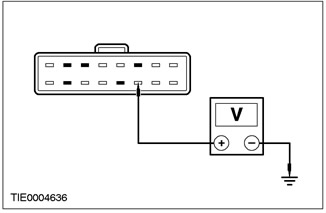
|
4 Measure the voltage between pin 14 of connector C488, driver's window power window switch, circuit 15 - LH14 (yellow-green) And "weight". |
|
• Is the voltage greater than 10 V? |
|
|
→ Yes |
|
|
Go to E8 |
|
|
→ No |
|
|
Repair circuit 15 - LH14 (yellow-green) CHECK the system is working properly. |
|
|
E8: DRIVER'S DOOR WINDOW SWITCH GROUND CIRCUIT CHECK |
|
|
1 Enter the OFF position. |
|
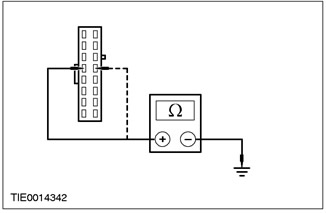
|
2 Measure the resistance between pin 5 (left hand drive variant) (pin 13, right-hand drive version) C488 Driver's Door Power Window Switch Connector Circuit 31 - AJ7 (black), And "weight". |
|
• Is the resistance less than 5 ohms? |
|
|
→ Yes |
|
|
CHECK the customer's complaint. |
|
|
→ No |
|
|
REPAIR circuit 31 - AJ7 (black). CHECK the system is working properly. |
|
|
E9: VOLTAGE CHECK IN DRIVER'S DOOR WINDOW SWITCH |
|
|
1 Enter the OFF position. |
|
|
2 Disconnect the C488 driver's window power window switch. |
|
|
3 Drive the ON position. |
|
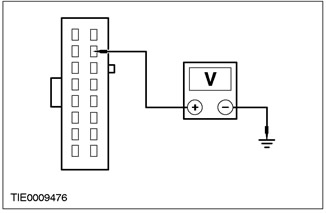
|
4 Measure the voltage between pin 15 of connector C488 of the driver's window power window switch, circuit 15 - AJ7 (green-blue), from the wiring side, and "weight". |
|
• Is the voltage greater than 10 V? |
|
|
→ Yes |
|
|
CHECK the customer's complaint. |
|
|
→ No |
|
|
REPAIR circuit 15-AJ7 (green-blue). CHECK the system is working properly. |
|
|
E10: CHECK THE SWITCHING VOLTAGE IN THE OPEN RELAY "ONE TOUCH" |
|
|
1 Enter the OFF position. |
|
|
2 Disconnect C738 opening relay "one touch". |
|
|
3 Drive the ON position. |
|
|
4 Operate the driver's window power window switch to the first detent in the down direction. |
|
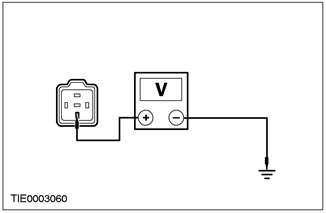
|
5 Measure the voltage between pin 3 of connector C738 of the opening relay "one touch00", electrical circuit 15S - AJ40 (green-blue), from the wiring side, and "weight". |
|
• Is the voltage greater than 10 V? |
|
|
→ Yes |
|
|
Go to E11 |
|
|
→ No |
|
|
REPAIR electrical circuit 15S - AJ40 (green-blue). CHECK the system is working properly. |
|
|
E11: CHECK THE IGNITION VOLTAGE SUPPLIED TO THE OPEN RELAY "ONE TOUCH" |
|
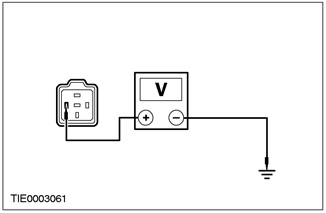
|
1 Measure the voltage between pin 2 of connector C738 of the opening relay "one touch", electrical circuit 15 - AJ15 (black and green), from the wiring side, and "weight". |
|
• Is the voltage greater than 10 V? |
|
|
→ Yes |
|
|
Go to E12 |
|
|
→ No |
|
|
REPAIR circuit 15 - AJ15 (black and green). CHECK the system is working properly. |
|
|
E12: CONTINUITY CHECK BETWEEN THE ONE-TOUCH RELAY AND "MASS" |
|
|
1 Enter the OFF position. |
|
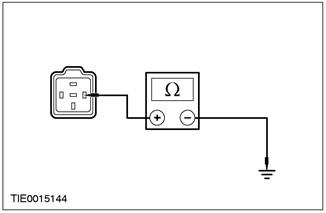
|
2 Measure the resistance between pin 1 of connector C738 of the opening relay "one touch", electric circuit 31 - AJ15 (black), from the wiring side, and "weight". |
|
• Is the resistance less than 5 ohms? |
|
|
→ Yes |
|
|
INSTALL a new opening relay "one touch". CHECK the system is working properly. |
|
|
→ No |
|
|
REPAIR circuit 31 - AJ15 (black). CHECK the system is working properly. |
|
|
E13: CONTINUITY CHECK OF THE ELECTRICAL CIRCUIT BETWEEN DRIVER'S POWER WINDOW MOTOR AND OPEN RELAY "ONE TOUCH". |
|
|
1 Enter the OFF position. |
|
|
2 Disconnect the C782 driver's window motor. |
|
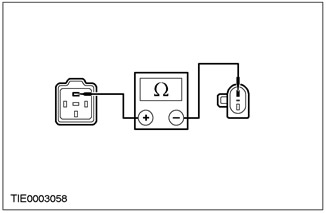
|
3 Measure the resistance between pin 2 of connector C782, driver's window motor, circuit 32 - AJ26 (white), on the wiring side, and pin 5 of connector C738 of the opening relay "one touch", electrical circuit 32 - AJ26 (white), from the side of the electrical wiring. |
|
• Is the resistance less than 5 ohms? |
|
|
→ Yes |
|
|
INSTALL a new opening relay "one touch". CHECK the system is working properly. CHECK the system is working properly. |
|
|
→ No |
|
|
REPAIR circuit 32 - AJ26 (white). CHECK the system is working properly. |
|
PINPOINT TEST F: POWER WINDOW DO NOT OPERATE ONE WINDOW - PASSENGER SIDE
|
STATES |
DETAILS/RESULTS/ACTIONS |
|
F1: VOLTAGE TEST IN PASSENGER DOOR WINDOW SWITCH |
|
|
1 Drive the ON position. |
|
|
• Is the passenger's door power window switch LED on? |
|
|
→ Yes |
|
|
Go to F2 |
|
|
→ No |
|
|
Go to F5 |
|
|
F2: PASSENGER DOOR WINDOW SWITCH GROUND ELECTRICAL CHECK |
|
|
1 Enter the OFF position. |
|
|
2 Disconnect the C489 passenger window power window switch. |
|
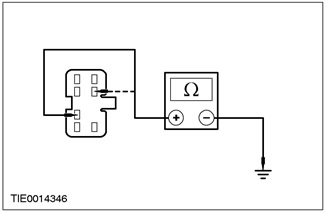
|
3 Measure the resistance between pin 3 of connector C489, passenger window power window switch, circuit 32 - AJ18 (white-violet), from the wiring side, and "weight"; and between pin 6 of connector C489, passenger window power window switch, circuit 33 - AJ18 (yellow-violet), from the wiring side, and "weight". |
|
• Is the resistance in all cases less than 5 ohms? |
|
|
→ Yes |
|
|
Go to F3 |
|
|
→ No |
|
|
Go to F7 |
|
|
F3: CONTINUITY CHECK OF THE ELECTRICAL CIRCUIT BETWEEN THE PASSENGER DOOR WINDOW SWITCH AND THE RELATED POWER WINDOW MOTOR |
|
|
1 Disconnect the passenger window motor.. |
|
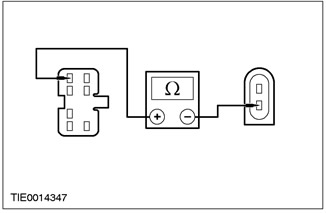
|
2 Measure the resistance between pin 1 of connector C489, passenger window power window switch, circuit 33 - AJ17 (yellow-violet) (left hand drive variant) (circuit 33 - AJ6 [yellow], right-hand drive version), wiring side, and pin 1 of connector C783, passenger window motor, circuit 33 - AJ17 (yellow-violet) (left hand drive variant) (circuit 33 - AJ6 [yellow], right-hand drive version), from the side of the electrical wiring. |
|
• Is the resistance less than 5 ohms? |
|
|
→ Yes |
|
|
Go to F4 |
|
|
→ No |
|
|
REPAIR circuit 33 - AJ17 (yellow-violet) (left hand drive variant) (circuit 33 - AJ6 [yellow], right-hand drive version). CHECK the system is working properly. |
|
|
F4: CONTINUITY CHECK OF THE ELECTRICAL CIRCUIT BETWEEN THE PASSENGER DOOR WINDOW SWITCH AND THE RELATED MOTOR |
|
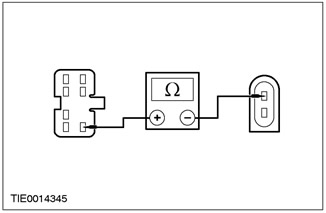
|
1 Measure the resistance between pin 7 of connector C489, passenger window power window switch, circuit 32 - AJ17 (white-violet) (left hand drive variant) (circuit 32 - AJ6 [white], right hand drive version), wiring side, and pin 2 of connector C783, passenger window motor, circuit 32 - AJ17 (white-violet), left-hand drive variant (circuit 32 - AJ6 [white], right hand drive version), from the side of the electrical wiring. |
|
• Is the resistance less than 5 ohms? |
|
|
→ Yes |
|
|
INSTALL a new power window motor. CHECK the system is working properly. |
|
|
→ No |
|
|
REPAIR circuit 32 - AJ17 (white-violet) (left hand drive variant) (circuit 32 - AJ6 [white], right hand drive version). CHECK the system is working properly. |
|
|
F5: VOLTAGE TEST IN PASSENGER DOOR WINDOW SWITCH |
|
|
1 Enter the OFF position. |
|
|
2 Disconnect the C489 passenger window power window switch. |
|
|
3 Drive the ON position. |
|
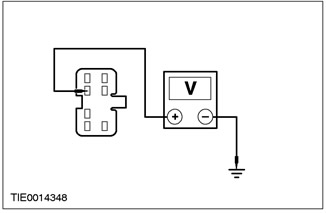
|
4 Measure the voltage between pin 2 of connector C489, passenger window power window switch, circuit 15 - AJ18 (white-green), from the wiring side, and "weight". |
|
• Is the voltage greater than 10 V? |
|
|
→ Yes |
|
|
Go to F6 |
|
|
→ No |
|
|
REPAIR circuit 15-AJ18 (white-green). CHECK the system is working properly. |
|
|
F6: PASSENGER DOOR WINDOW SWITCH GROUND CIRCUIT CHECK |
|
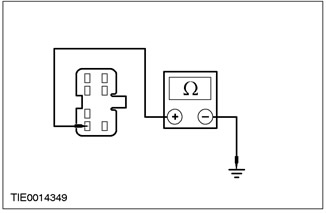
|
1 Measure the resistance between pin 4 of connector C489, passenger window power window switch, circuit 31 - LH31 (black), from the wiring side, and "weight". |
|
• Is the resistance less than 5 ohms? |
|
|
→ Yes |
|
|
CHECK the customer's complaint. |
|
|
→ No |
|
|
REPAIR circuit 31-LH31 (black). CHECK the system is working properly. |
|
|
F7: CONTINUITY CHECK OF THE ELECTRICAL CIRCUIT BETWEEN THE DRIVER'S POWER WINDOW SWITCH AND THE PASSENGER'S DOOR WINDOW SWITCH |
|
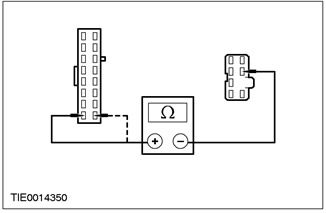
|
1 Measure the resistance between pin 1 of connector C488, driver's window power window switch, circuit 33 - AJ18 (yellow-violet) (left hand drive variant) (pin 9, right-hand drive version), and pin 6 of connector C489, passenger window power window switch, circuit 33 - AJ18 (yellow-violet). |
|
• Is the resistance less than 5 ohms? |
|
|
→ Yes |
|
|
Go to F8 |
|
|
→ No |
|
|
REPAIR circuit 33-AJ18 (yellow-violet). CHECK the system is working properly. |
|
|
F8: CONTINUITY CHECK OF THE ELECTRICAL CIRCUIT BETWEEN THE DRIVER'S POWER WINDOW SWITCH AND THE PASSENGER'S DOOR WINDOW SWITCH |
|
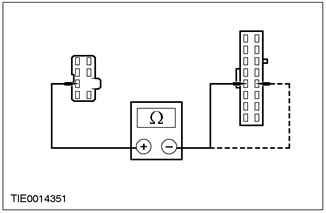
|
1 Measure the resistance between pin 4 of connector C488, driver's window power window switch, circuit 32 - AJ18 (white-violet), (left hand drive variant) (pin 12, right-hand drive version), and pin 3 of connector C489 passenger window switch, circuit 32 - AJ18 (white-violet). |
|
• Is the resistance less than 5 ohms? |
|
|
→ Yes |
|
|
CHECK the customer's complaint. |
|
|
→ No |
|
|
REPAIR Circuit 32 - AJ18 (white-violet). CHECK the system is working properly. |
|
PINPOINT TEST G: OPENING FUNCTION DOES NOT WORK "ONE TOUCH"
|
STATES |
DETAILS/RESULTS/ACTIONS |
|
G1: OPEN RELAY OPERATIONAL TEST "ONE TOUCH" |
|
|
1 Drive the ON position. |
|
|
2 Operate the driver's window power window switch to the second detent in the down direction. |
|
|
• Does the relay click? |
|
|
→ Yes |
|
|
Go to G2 |
|
|
→ No |
|
|
Go to G3 |
|
|
G2: CHECK THE IGNITION VOLTAGE SUPPLIED TO THE OPEN RELAY "ONE TOUCH" |
|
|
1 Enter the OFF position. |
|
|
2 Disconnect the C738 one-touch open relay.. |
|
|
3 Drive the ON position. |
|
|
4 Operate the driver's window power window switch to the second detent in the down direction. |
|
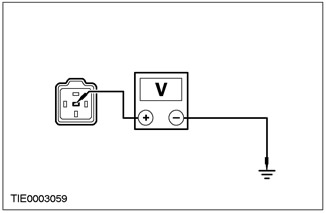
|
5 Measure the voltage between pin 4 of connector C738 of the opening relay "one touch", electrical circuit 15S - AJ42 (black and green), from the wiring side, and "weight". |
|
• INSTALL a new opening relay "one touch". CHECK the system is working properly. |
|
|
→ Yes |
|
|
INSTALL a new opening relay "one touch". CHECK the system is working properly. |
|
|
→ No |
|
|
REPAIR circuit 15S - AJ42 (black and green). CHECK the system is working properly. |
|
|
G3: VOLTAGE CHECK IN OPEN RELAY "ONE TOUCH" |
|
|
1 Disconnect C738 opening relay "one touch". |
|
|
2 Drive the ON position. |
|
|
3 Operate the driver's window power window switch to the second detent in the down direction. |
|
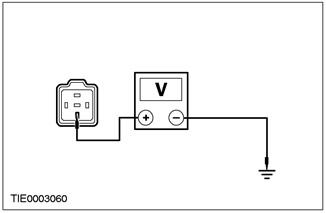
|
4 Measure the voltage between pin 3 of connector C738 of the opening relay "one touch", electrical circuit 15S - AJ40 (green-blue), from the wiring side, and "weight". |
|
• Is the voltage greater than 10 V? |
|
|
→ Yes |
|
|
INSTALL a new opening relay "one touch". CHECK the system is working properly. CHECK the system is working properly. |
|
|
→ No |
|
|
REPAIR electrical circuit 15S - AJ40 (green-blue). CHECK the system is working properly. |
|
PINPOINT TEST H: DEICING SYSTEM DOES NOT WORK
|
STATES |
DETAILS/RESULTS/ACTIONS |
|
NOTE: This symptom also applies to the de-icing system for heated mirrors and heated windshield. If heated rear window and door mirrors do not work, GO to H1; if heated windshield does not work, GO to H14. |
|
|
H1: PRESS THE HEATED REAR WINDOW SWITCH. |
|
|
1 Drive the ON position. |
|
|
2 Operate the heated rear window switch |
|
|
• Does the heated rear window relay click? |
|
|
→ Yes |
|
|
Go to H2 |
|
|
→ No |
|
|
Move to H4 |
|
|
H2: EXTERIOR MIRRORS HEATED OPERATION CHECK |
|
|
1 Operate the heated rear window switch. |
|
|
• Heated exterior mirrors working correctly? |
|
|
→ Yes |
|
|
Go to H3 |
|
|
→ No |
|
|
Go to H7 |
|
|
H3: REAR WINDOW HEATED ELECTRICAL CIRCUIT CHECK |
|
|
1 Operate the heated rear window switch. |
|
|
• Does the heated rear window work correctly? |
|
|
→ Yes |
|
|
CHECK the customer's complaint. |
|
|
→ No |
|
|
Go to H10 |
|
|
H4: CHECK IGNITION VOLTAGE IN HEATED REAR WINDOW RELAY |
|
|
1 Enter the OFF position. |
|
|
2 Disconnect the C1025 heated rear window relay. |
|
|
3 Drive the ON position. |
|
|
4 Operate the heated rear window switch. |
|
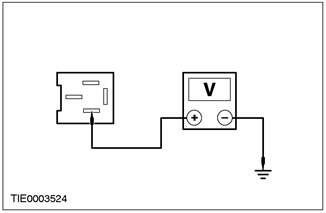
|
5 Measure the voltage between pin 1 of the C1025 heated rear window relay connector, circuit 15 - DA1 (yellow-green), from the wiring side, and "weight". |
|
• Is the voltage greater than 10 V? |
|
|
→ Yes |
|
|
Move to H5 |
|
|
→ No |
|
|
REPAIR the central electrical box. CHECK the system is working properly. |
|
|
H5: CONTINUITY CHECK BETWEEN REAR WINDOW HEATED RELAY AND CENTRAL TIMER MODULE |
|
|
1 Enter the OFF position. |
|
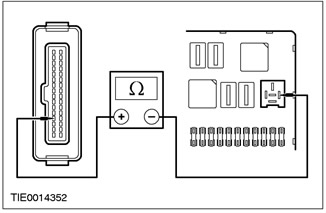
|
2 Measure the resistance between pin 2 of the C1025 heated rear window relay (CJB), on the wiring side, and pin 4 of the C1000 connector of the central timer module (CJB), from the side of the electrical wiring. |
|
• Is the resistance less than 5 ohms? |
|
|
→ Yes |
|
|
Go to H6 |
|
|
→ No |
|
|
REPAIR the central electrical box. CHECK the system is working properly. |
|
|
H6: CENTRAL TIMER MODULE GROUND CONTINUITY CHECK |
|
|
1 Operate the heated rear window switch |
|
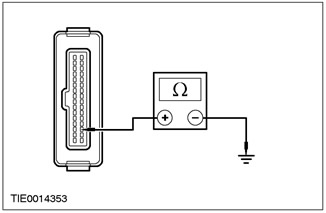
|
2 Measure the resistance between pin 19 of connector C1000 of the central timer module (CJB), from the wiring side, and "weight". |
|
• Is the resistance less than 5 ohms? |
|
|
→ Yes |
|
|
INSTALL a new heated rear window relay. CHECK the system is working properly. |
|
|
→ No |
|
|
Go to H12 |
|
|
H7: FUSE VOLTAGE CHECK 51 (7.5A) CENTRAL JUNCTION BOX (CJB) |
|
|
1 Disconnect Fuse 51 (7.5A). |
|
|
2 Drive the ON position. |
|
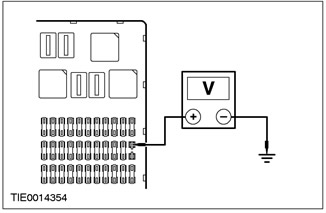
|
3 Measure voltage between fuse input terminal 51 (7.5A) And "weight". |
|
• Is the voltage greater than 10 V? |
|
|
→ Yes |
|
|
Go to H8 |
|
|
→ No |
|
|
REPAIR the central electrical box. CHECK the system is working properly. |
|
|
H8: DRIVER AND PASSENGER EXTERIOR MIRRORS VOLTAGE CHECK |
|
|
1 Connect Fuse 51 (7.5 A). |
|
|
2 Drive the ON position. |
|
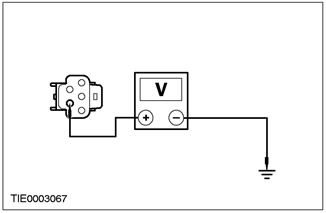
|
3 Measure the voltage between pin 4 of the exterior mirror connector C807 on the driver's side, on the wiring side, and "weight"; and between pin 4 of the exterior mirror connector C808 on the passenger side, wiring side, and "weight" |
|
• Is the voltage always greater than 10 V? |
|
|
→ Yes |
|
|
Move to H9 |
|
|
→ No |
|
|
REPAIR circuits 15S - HB2 (green-blue), 15S - HB15 (black and green) or 15S - HB35 (black and green) from the driver's side; or electric circuit 15S - HB2 (green-blue), 15S - HB28 (green-orange) or 15S - HB36 (green-orange) from the passenger side. CHECK the system is working properly. |
|
|
H9: DRIVER AND PASSENGER EXTERIOR MIRRORS GROUND CONTINUITY CHECK |
|
|
1 Enter the OFF position. |
|
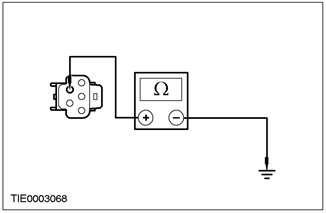
|
2 Measure the resistance between pin 5 of the exterior mirror connector C807 on the driver's side, on the wiring side, and "weight"; and between pin 5 of the exterior mirror connector C808 on the passenger side, wiring side, and "weight". |
|
• Is the resistance in all cases less than 5 ohms? |
|
|
→ Yes |
|
|
INSTALL a new exterior mirror (A) with heating. CHECK the system is working properly. |
|
|
→ No |
|
|
REPAIR circuit 31 - HB35 (black) from the driver's side; or circuit 31 - HB36 (black) from the passenger side. CHECK the system is working properly. |
|
|
H10: VOLTAGE CHECK IN HEATED REAR WINDOW NET |
|
|
1 Enter the OFF position. |
|
|
2 Disconnect the C949 heated rear screen. |
|
|
3 Drive the ON position. |
|
|
4 Measure the voltage between pin 1 of connector C949, rear defroster grid, circuit 15S - HB19 (green-blue), from the wiring side, and "weight". |
|
|
• Is the voltage greater than 10 V? |
|
|
→ Yes |
|
|
5 - door version: INSTALL a new heated rear window. CHECK the system is working properly. 4 - door version and "station wagon": Go to H11 |
|
|
→ No |
|
|
REPAIR circuit 15S-HB19 (green-blue). CHECK the system is working properly. |
|
|
H11: REAR WINDOW HEATED GRID GROUND ELECTRICAL CHECK |
|
|
1 Enter the OFF position. |
|
|
2 Connect C951/C949 heated rear screen. |
|
|
3 Disconnect the C950 heated rear screen. |
|
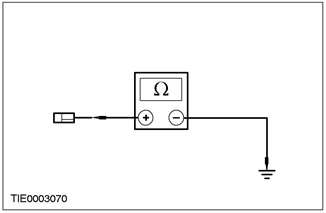
|
4 Measure the resistance between pin 1 of connector C950, rear defroster grid, circuit 31 - HB19 (black), from the wiring side, and "weight". |
|
• Is the resistance less than 5 ohms? |
|
|
→ Yes |
|
|
INSTALL a new heated rear window. CHECK the system is working properly. |
|
|
→ No |
|
|
REPAIR circuit 31 - HB35 (black). CHECK the system is working properly. |
|
|
H12: CONTINUITY CHECK OF THE ELECTRICAL CIRCUIT BETWEEN THE CENTRAL TIMER MODULE AND THE HEATER CONTROL MODULE |
|
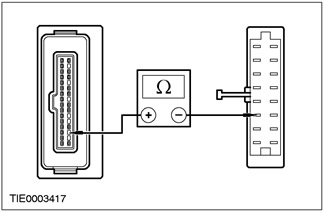
|
1 Measure the resistance between pin 19 of connector C1000 of the central timer module (CJB), on the wiring side, and pin 3 of connector C380 of the heater control module, circuit 31S - HB1 (black and blue), from the side of the electrical wiring. |
|
• Is the resistance less than 5 ohms? |
|
|
→ Yes |
|
|
Go to H13 |
|
|
→ No |
|
|
REPAIR circuit 31S-HB1 (black and blue). CHECK the system is working properly. |
|
|
H13: CONTINUITY CHECK OF THE HEATER CONTROL MODULE GROUND ELECTRIC CIRCUIT |
|
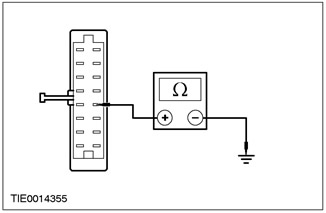
|
1 Measure the resistance between pin 12 of connector C380 of the heater control module, circuit 91 - FA13 (black-orange), from the wiring side, and "weight". |
|
• Is the resistance less than 5 ohms? |
|
|
→ Yes |
|
|
INSTALL a new heater control module. CHECK the system is working properly. |
|
|
→ No |
|
|
REPAIR circuit 91 - FA13 (black and orange). CHECK the system is working properly. |
|
|
H14: HEATED WINDSHIELD RELAY TEST |
|
|
1 Drive the START position. |
|
|
2 Drive the ON position. |
|
|
3 With the engine running, turn on the heated windshield switch. |
|
|
• Does the relay operate with a distinct sound? |
|
|
→ Yes |
|
|
Go to H15 |
|
|
→ No |
|
|
Go to H18 |
|
|
H15: HEATED WINDSHIELD VOLTAGE CHECK |
|
|
1 Enter the OFF position. |
|
|
2 Disconnect C634 and C635 heated windshield. |
|
|
3 Drive the START position. |
|
|
4 Drive the ON position. |
|
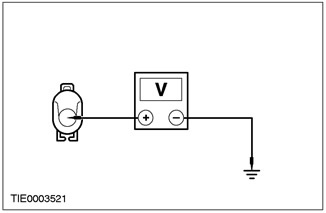
|
5 Measure the voltage between pin 1 of connector C634, left section of heated windscreen grid, circuit 64S - HB12 (blue), from the wiring side, and "weight"; and between pin 1 of connector C635 of the right section of the heated windscreen grid, circuit 64S - HB25 (red-blue), from the wiring side, and "weight". |
|
• Is the voltage always greater than 10 V? |
|
|
→ Yes |
|
|
Go to H16 |
|
|
→ No |
|
|
Go to H21 |
|
|
H16: HEATED WINDSHIELD GRID GROUND ELECTRICAL CHECK |
|
|
1 Enter the OFF position. |
|
|
2 Measure the resistance between the heated windshield and "weight". |
|
|
• Is the resistance in all cases less than 5 ohms? |
|
|
→ Yes |
|
|
Go to H17 |
|
|
→ No |
|
|
REPAIR the heated windshield ground circuit. CHECK the system is working properly. |
|
|
H17: CHECK HEATED WINDSHIELD GRIDS |
|
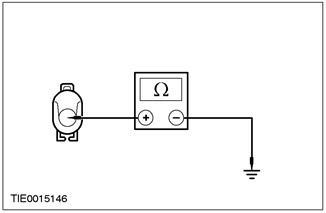
|
1 Measure the resistance between pin 1 of connector C634 of the defroster grid (left section), from the wiring side, and "weight"; and between pin 1 of connector C635 of the heated windscreen grid (right section), from the wiring side, and "weight". |
|
• Is the resistance greater than 10,000 ohms? |
|
|
→ Yes |
|
|
INSTALL a new windshield. CHECK the system is working properly. |
|
|
→ No |
|
|
CHECK the customer's complaint. |
|
|
H18: HEATED WINDSHIELD RELAY VOLTAGE CHECK |
|
|
1 Enter the OFF position. |
|
|
2 Disconnect the C1003 heated windshield relay. |
|
|
3 Drive the START position. |
|
|
4 Drive the ON position. |
|
|
5 Measure the voltage between pin 1 of the C1003 heated windshield relay, circuit 64 - HB7 (red-blue), from the wiring side, and "weight". |
|
|
• Is the voltage greater than 10 V? |
|
|
→ Yes |
|
|
Go to H19 |
|
|
→ No |
|
|
REPAIR circuit 64 - HB7 (red-blue). CHECK the system is working properly. |
|
|
H19: CENTRAL TIMER MODULE GROUND CONTINUITY CHECK |
|
|
1 Enter the OFF position. |
|
|
2 Operate the heated windshield switch. |
|
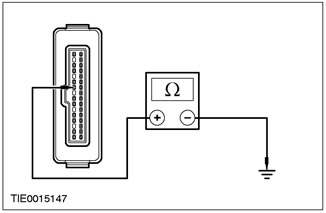
|
3 Measure the resistance between pin 10 of connector C1000 of the central timer module, harness side, and "weight". |
|
• Is the resistance less than 5 ohms? |
|
|
→ Yes |
|
|
Go to H20 |
|
|
→ No |
|
|
Go to H22 |
|
|
H20: CONTINUITY CHECK BETWEEN HEATED WINDSHIELD RELAY AND CENTRAL TIMER MODULE |
|
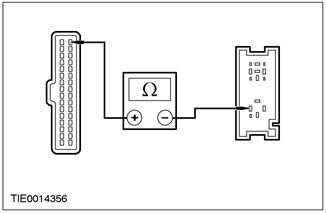
|
1 Measure the resistance between pin 2 of the C1003 heated windshield relay, circuit 31S - HB7 (black and blue), on the wiring side, and pin 32 of connector C1000 of the central timer module (CJB), from the side of the electrical wiring. |
|
• Is the resistance less than 5 ohms? |
|
|
→ Yes |
|
|
INSTALL a new heated windshield relay. CHECK the system is working properly. |
|
|
→ No |
|
|
REPAIR circuit 31S-HB7 (black and blue). CHECK the system is working properly. |
|
|
H21: CONTINUITY CHECK OF THE ELECTRICAL CIRCUIT BETWEEN HEATED WINDSHIELD RELAY AND HEATED WINDSHIELD MESH |
|
|
1 Enter the OFF position. |
|
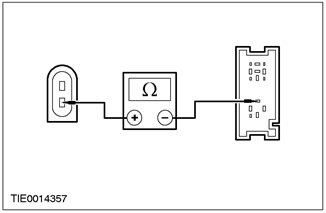
|
2 Measure the resistance between pin 5 of connector C1003 heated windshield relay circuit 64S - HB1 (red-blue), on the wiring side, and pin 1 of connector C634 of the left section of the heated windscreen grid, circuit 64S - HB12 (blue), from the wiring side; and pin 1 of connector C635, right-hand heated windshield, circuit 64S - HB25 (red-blue), from the side of the electrical wiring. |
|
• Is the resistance in all cases less than 5 ohms? |
|
|
→ Yes |
|
|
INSTALL a new heated windshield relay. CHECK the system is working properly. |
|
|
→ No |
|
|
REPAIR circuit 64S - HB1 (red-blue), electrical circuit 64S - HB12 (blue) or electric circuit 64S - HB25 (red-blue). CHECK the system is working properly. |
|
|
H22: CONTINUITY CHECK OF THE ELECTRICAL CIRCUIT BETWEEN THE CENTRAL TIMER MODULE AND THE HEATER CONTROL MODULE |
|
|
1 Enter the OFF position. |
|
|
2 Disconnect the C1000 central timer module. |
|
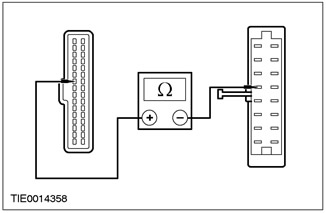
|
3 Measure the resistance between pin 10 of connector C1000 of the central timer module (CJB), on the wiring side, and pin 5 of connector C380 of the heater control module (CJB), from the side of the electrical wiring. |
|
• Is the resistance less than 5 ohms? |
|
|
→ Yes |
|
|
Go to H23 |
|
|
→ No |
|
|
REPAIR circuit 31S-HB9 (black and white). CHECK the system is working properly. |
|
|
H23: HEATER CONTROL MODULE GROUND ELECTRICAL CHECK |
|
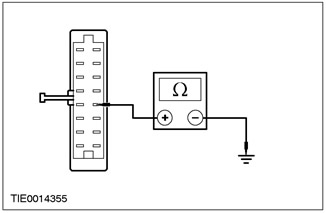
|
1 Measure the resistance between pin 12 of connector C380 of the heater control module (CJB), from the wiring side, and "weight". |
|
• Is the resistance less than 5 ohms? |
|
|
→ Yes |
|
|
INSTALL a new heater control module. CHECK the system is working properly. |
|
|
→ No |
|
|
REPAIR circuit 91 - FA13 (black and orange). CHECK the system is working properly. |
|
Visitor comments